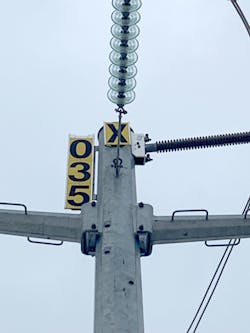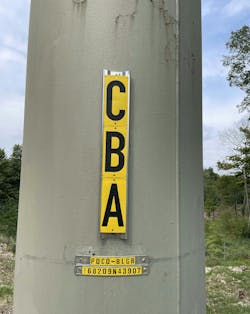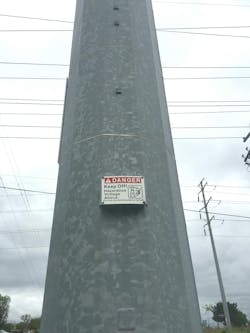Signs up Above: Assuring Transmission Tower Safety with Highly Visible, Long-Lasting Signage
When a widespread power outage occurs and high-voltage transmission lines require immediate repairs, the electric utility often sends a skilled technician to the location by helicopter to speed the repair process. Helicopters, along with drones, are also used for monitoring, inspecting and maintaining transmission towers and power lines. Lineworkers often work on transmission lines that are not de-energized, allowing for an uninterrupted power supply.
Of course, working near high-voltage lines poses significant electrical hazards. Flying close to high-voltage lines, often in challenging weather conditions, increases the risk of a crash. The pilots and crew must adhere to strict safety protocols to avoid accidental contact with live wires. An electrical arc flash can also cause severe burns or other injuries, so workers wear protective clothing and use insulated tools.
“Given the high-risk nature of the operation, there can be no tolerance for inadequate or unreadable safety signage. When a technician is suspended hundreds of feet above ground or a drone must fly close to the line, having easily readable, visible signage ensures the crew is at the correct location and understands the potential dangers and hazards in the area,” says Daniel O'Connor, General Manager of New York-based Tech Products, Inc., a manufacturer of industrial identification products for 76 years.
According to O'Connor, transmission towers require aerial observation tower/pole identification tags, crossing signs, warning signs as well as various other crucial tags and markers. To mitigate risk and liability, towers and other restricted areas also need to display warnings of the deadly electrocution and fall hazards to prevent unauthorized access or attempts to climb the structure from the ground.
From the Air
When helicopters or drones are involved, aerial observation tags are vitally important to quickly identify the location of a high-voltage tower from the air. Aerial observation tags are typically made of metal or plastic and installed horizontally or vertically using vandal-proof mounts on posts or stakes. The brightly colored, high-contrast numbers and letters typically indicate the line number, section and tower/pole number.
Because of the importance of identifying the correct tower, aerial surveillance markers must be readily visible for many years despite continual exposure to sun, rain, snow, sleet, wind and even corrosive elements like acid rain. Unfortunately, traditional painted and laminated identification products frequently fade or delaminate when continually exposed to outdoor weather or punishing conditions. Even supposedly durable products designed for this purpose can become unreadable over 10 years or more.
Even operators attempting to view aerial markers through the drone’s high-resolution camera may find it difficult without flying closer than needed to the power lines. Operating drones near power lines presents several challenges and dangers, including increasing the risk of arcing. Additionally, strong winds near power lines can destabilize drones, increasing the risk of collisions.
The alternative is more durable signage made of high-impact polyolefin plastic like the EVERLAST® brand from Tech Products, a manufacturer of identification products for the electric and gas utilities, telecommunication and cable companies, OEMs and pipeline companies. EVERLAST signs and tags display text or pictograms that are permanently embedded through the entire thickness of the substrate. UV stabilizers and antioxidants are added to provide complete protection and weather resistance in all climates.
For optimal visibility at a distance, polyolefin plastic aerial observation tags come in sizes ranging from 6 in. to 12 in., the largest in the industry. According to O’Connor, Entergy, a Fortune 500 integrated energy company, has used this type of signage on their transmission towers since 1989.
Polyolefin plastic signage is also used to identify nearby lines or to indicate unexpected changes in the elevation or direction of the line. For the helicopter crew, crossing lines can be very dangerous, particularly in low visibility conditions. To prevent this from happening, signs are posted. Within the industry, it is typical to clearly indicate a power cable crossing with signage marked by an “X” or a change in direction with an arrow.
“When a helicopter crew is flying at high speeds, any power cables in the vicinity or any sudden directional changes can increase the possibility of a serious accident. Crossing signs mitigate the risk but must be clearly visible in any weather conditions. The embedded characters help to ensure readability decades later,” says O’Connor, adding that EVERLAST crossing signs are available in a large 10 in. by 14 in. format to promote optimum visibility.
Signage is also necessary to signify specific levels of danger or required precautions with OSHA-compliant color codes.
AC transmission lines can carry transmission voltages from 69 kv up to 765 kv, which can be extremely dangerous, and even fatal. As a result, electric utility transmission and distribution identification products such as safety signs, tags and markers are critical to safe, efficient operation, maintenance and repair. These brief warnings or instructions, comprised of letters, numbers and symbols, must effectively convey key information to personnel.
On large, high-voltage transmission towers, phase tags are commonly used to indicate phase polarity on the towers, which is important because connecting the wrong phases can lead to dangerous explosions, serious injury and extended downtime.
In addition to towers, smaller, lower-voltage distribution lines deliver power to homes and businesses on smaller poles. Pole identification products, such as tags and markers, are used to track and identify assets, data and other vital information. Pole tags can also be used to identify the pole’s owner, maintenance history and other valuable data.
“When lasting transmission and distribution markers are required, another alternative is deeply embossed pole markers made of unpainted, embossed aluminum, brass, or stainless steel. The highly defined characters remain legible for the life of the pole,” says O'Connor.
When the tags need to be seen with a flashlight, metal reflective pole tags with screen-printed black characters on construction-grade yellow or silver reflective sheeting are a good option.
From the Ground
Unfortunately, there have been numerous recent reports over the years of fatalities and severe injuries from people climbing high-voltage transmission towers for thrill-seeking, protest, vandalism or theft of metals.
To dissuade this type of behavior and limit any potential liability, safety warnings are posted on poles, towers, fences surrounding substations and at entry points to restricted areas. The brightly colored signs that warn the public of “Danger!” “High Voltage Overhead,” “Electrocution Hazard,” or to “Keep Out.” International symbols related to electrical hazards as well as safety colors such as red, orange or yellow are often included.
“Climbing a transmission tower can be a life-threatening event, risking extreme liability, if warnings and precautions do not comply with OSHA, ANSI, and other regulatory standards,” says O'Connor.
To remain ANSI compliant, the signage or tags must not only retain its readability, but the color distinctions must be maintained as well over the long term.
“We always make sure our signs are OSHA/ANSI compliant,” explains O’Connor. “However, it is not just what the sign says, but also its colors. A safety red must stay red for the life of the sign, or it may no longer be considered compliant with OSHA regulations, even if it has been twenty-five years,” says O’Connor.
With the stakes of quickly restoring power to urban areas so high today, utilities need to effectively utilize industry best practice signage, tags, and markers to help their technicians quickly, safely identify and resolve any issues in transmission towers and poles. Those that do so will benefit greatly over the long term in increased uptime and safety while substantially reducing labor, maintenance and potential liability.
This article was provided by Tech Products. For more information, call 1-800-221-1311; email [email protected]; or visit www.techproducts.com.




